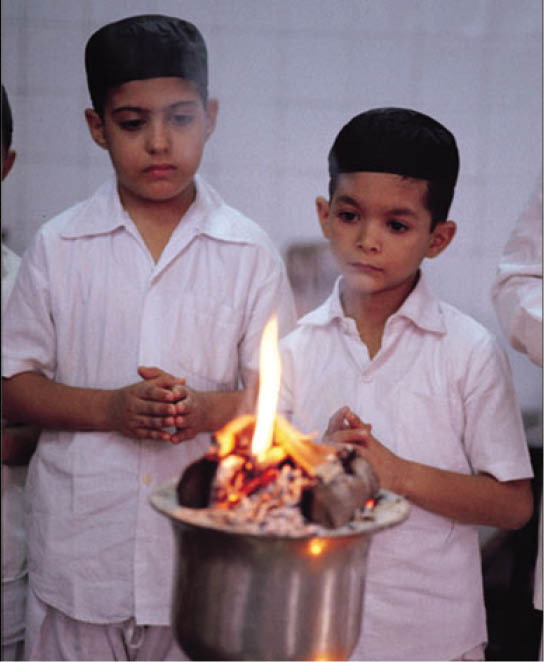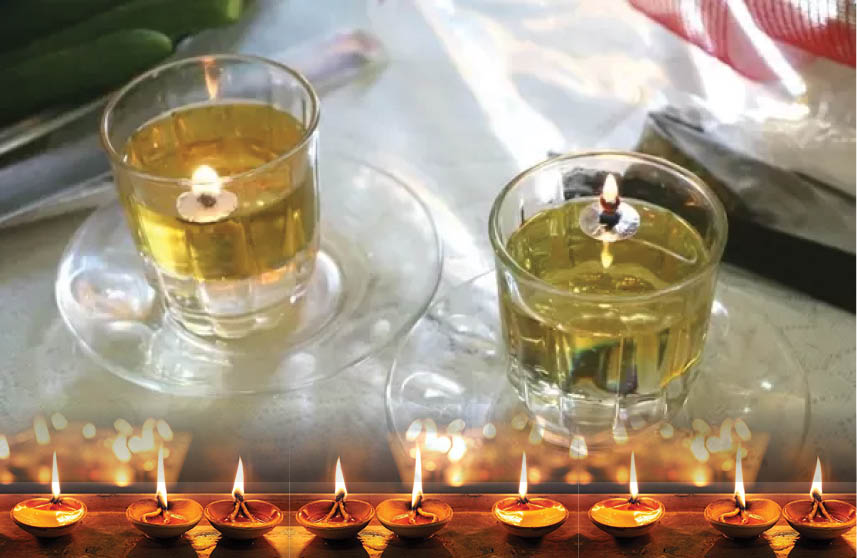 Diwali is the five-day festival of light, celebrated by millions across the world. The festival coincides with the Hindu New Year and thus also celebrates new beginnings and the triumph of good over evil and light over darkness. Diwali also commemorates Lakshmi, the Divinity of wealth and prosperity.
Diwali is the five-day festival of light, celebrated by millions across the world. The festival coincides with the Hindu New Year and thus also celebrates new beginnings and the triumph of good over evil and light over darkness. Diwali also commemorates Lakshmi, the Divinity of wealth and prosperity.
Five Days of Festivity: The five days of festivity begin with Dhanteras (the day of good fortune), followed by Naraka Chaturdasi (the day of knowledge and also the day Goddess Kaali destroys the demon of ignorance Narakasura), followed by Diwali (the day of light), followed by Annakut (meaning mountain of food and celebrated as the New Year’s day) and finally Bhai Duj (the day to celebrate sibling love).
The Zoroastrian Festival of Light: Diwali, the festival of light is generally celebrated in the month of October and interestingly, according to the seasonal (Fasli) Zoroastrian calendar, the festival of Meherangan (Meher Roj of Meher Mah) which commemorates the Divinity of light, is also celebrated in the month of October. Like Diwali, Meherangan commemorates the victory of light over the forces of darkness; and good over the forces of evil. It is the day when the legendary spiritual King, Shah Faridoon enchains Zohak or Azi Dahak, the epitome of evil, to mount Damavand in Iran.
According to legend, Zohak (the embodiment of evil) is still chained to mount Damavand, and it is said that every night as darkness grows, the forces of evil gain strength and the chains weaken. However, at the crack of dawn, when the rooster crows and there is sunlight, the chains are again secured and the evil one is rendered powerless. This is an important truth in nature, wrapped in an easy-to-understand legend. Neither darkness nor evil has its own existence. Darkness is the absence of light and evil the absence of good.
Light and Darkness: The only way to negate darkness is with light and the only way to dispel evil is through thoughts, words and deeds that are good. Darkness will only swallow darkness and deepen. Darkness can only be vanquished with light and evil can only be vanquished with goodness. Evil cannot, and will not, be vanquished with evil. The theory of ‘an eye for an eye and tooth for a tooth’ will only make the world blind and toothless.
Significance of Lighting Lamps: The most common icon which captures the spirit of Diwali is the oil lamp or diya, lighting up millions of homes and establishments with joy and hope. Zoroastrians also light oil lamps or the diva at home and at offices and not just on festive days, but, every day. In a sense, Zoroastrians celebrate light every single day, be it while praying the Meher Yasht (hymn) or the Meher Niyaish (litany) to sunlight or while praying before a consecrated fire or a hearth fire at home.
Zoroastrians Revere Light: Zoroastrians are often, erroneously perceived as ‘fire-worshipers’. However, Zoroastrians essentially revere light, especially the light of knowledge and wisdom. As a community, we literally and figuratively light up any occasion with our sense of humour, our sense of giving and above all else, our sense of life and living.
We have our dark side and dark traits too (often lightly passed off as our idiosyncrasies). However, just as darkness is required to see the stars and the moon, Parsis perhaps cannot be seen for who they really are without their idiosyncrasies. And, so, we merrily continue our tango with darkness and light with the hope and prayer that the fine balance will never be violently disturbed.
How and Why Do We Light the Diva?
We can choose to light a diva mechanically or with deeper understanding and positive affirmation. As we all know, light carries the energy required to sustain life on earth. Without light we are unable to see anything. Thus, while we light oil lamps to usher in light and dispel darkness, more importantly, since Ardibehesht (the Divinity of Truth and Righteousness and Giver of Good Health) also presides over fire, we light the divo to celebrate truth, righteousness and invite good health and good living.
In Zoroastrian tradition, we light a diva reciting five Yatha. The Avestan Yatha Ahu Vairyo prayer, also known as the ‘Ahunavar’, is the equivalent of the Sanskrit ‘Om’. In Hindu tradition, Brahma creates the universe chanting ‘Om’, whereas in Zoroastrianism, Ahura Mazda creates the universe chanting the Ahunavar. In other words, the Ahunavar is a creative and life-giving chant.
When lighting the diva and simultaneously chanting the Yatha Ahu Vairyo five times, we should understand that we are not just dispelling darkness from our surroundings, but also dispelling the darkness of doubt and depression from our minds.
Positive Affirmations: With the recitation of each Yatha, we should affirm that our five senses (vision, hearing, smell, taste and touch) become more enhanced, creative and positive. Pray for foresight; Pray that you hear only good, no evil; Pray that you smell success; Pray that you taste love; and Pray that you touch lives in a positive way, each day of your life.
When the mind is fed with positive affirmations, it begins to resonate with light, and such a person starts to exude the light of life itself. A person who is very knowledgeable, wise and compassionate is called ‘enlightened’. The term ‘enlighten’ comes from the metaphor that ignorance is a state of being ‘in the dark’ and that knowledge, wisdom and compassion is illuminating.
This Festival of Light let us resolve that we will not just celebrate light, but, endeavour to become the light that will enliven and enlighten the lives of all those whose lives we touch.
Be the sunlight that cheers many a mood and live your life like the verse written by Hafez: “Even after all this time the sun never says to the earth, ‘you owe me’. Look what happens with a love like that, it lights the whole sky!”
- Celebrating Motherhood - 11 May2024
- Parsi Thy Name Is Humour! - 4 May2024
- The Poison of Pessimism - 27 April2024
